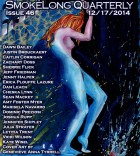This piece begins as speculation. At the start, you pitch a curve ball of may-or-may-not-have-beens (“Let’s say . . .”), as the narrator suggests she may have just been robbed and shot while pushing her daughter on the swings in the park across the street from a church, but then you immediately lock us into the narrator’s unfolding thoughts in present tense, the ever-urgent is. Given the way you play with tense, time, and consciousness, it makes me question what I know. Is anything in this life real? How do you know for sure?
The narrator starts by saying, “Let’s say I’m being robbed, but I choose to believe I’m pushing my daughter on the swings . . . ,” which sets up the possibility of a robbery, but not the swings. She chooses to believe she’s elsewhere, someplace peaceful and happy, as someone in a traumatic situation might do, but even that has a twist to it as her daughter ages with each push. As her mind wanders, she provides specific details of some events she would know and other events she couldn’t possibly know. There’s a breathless quality to her stream of consciousness, and a slowing down and speeding up of time as she tries to make sense of what’s happening.
In contrast, she tells little about the robbery. All she says is “He shoots me in the chest and runs”—assuming, of course, there really is a robbery.
The metaphorical glue that holds this story together seems to be worry, specifically the rampant, pointless, feverish worry of motherhood. The narrator worries about how fast her daughter is growing up, about germs on the finger plugging her bullet wound, about her will, the insurance policy, the anger of a child after a trauma. The mother of the shooter, seen through the awareness of the narrator, worries about what she could have done to make things different for the heap of human error that is her son. Worry is a membrane connecting rather than separating these women, to the extent that it seems perfectly reasonable one would know the thoughts of the other. With this in mind, should anyone ever have children? If yes, how can you possibly justify the end of so much sanity? If no, how can you possibly justify the end of the human race?
I think people have children before they realize how much worry goes into the process of raising them. Another connection the characters share is that their lives are irrevocably changed. They probably all wish they could start the day again and make it different.
In this piece, you play with time. The child ages with every push, grows older than her mother, loses her childhood. Recently, I found my ten-year-old daughter smearing something like all the makeup on her face, rather expertly. Does this mean I’m dying?
We’re all dying. It’s only a question of when the process becomes final. This narrator may be feeling time fluctuate as her brain processes what she’s done with her life and what she never got around to doing.
Given the gorgeous open-endedness you’ve achieved here, what would you say to pacify a climax-centric reader, one who craves resolution like an orgasm, followed by the certainty of death and a nap?
I would offer up a conciliatory copy of Robert Coover’s “The Babysitter,” sit where I could watch, and wait with anticipated amusement. Just for sport.
Finally, paying homage to the mothers of your story, a series of What-Ifs: What if insomnia could be monetized? What if stories created alternate dimensions where characters actually lived? What if mimes were sexy? What if net neutrality actually fails?
Insomnia has been monetized; Google it and count the companies.
Etgar Keret has already shown, in his story “Lieland,” that characters in the lies we tell do exist in another dimension, so why not characters in stories?
Aren’t mimes sexy to other mimes?
If net neutrality fails, somehow we will all go on.



 The core workshop of SmokeLong Fitness is all in writing, so you can take part from anywhere at anytime. We are excited about creating a supportive, consistent and structured environment for flash writers to work on their craft in a community. We are thrilled and proud to say that our workshop participants have won, placed, or been listed in every major flash competition. Community works.
The core workshop of SmokeLong Fitness is all in writing, so you can take part from anywhere at anytime. We are excited about creating a supportive, consistent and structured environment for flash writers to work on their craft in a community. We are thrilled and proud to say that our workshop participants have won, placed, or been listed in every major flash competition. Community works.